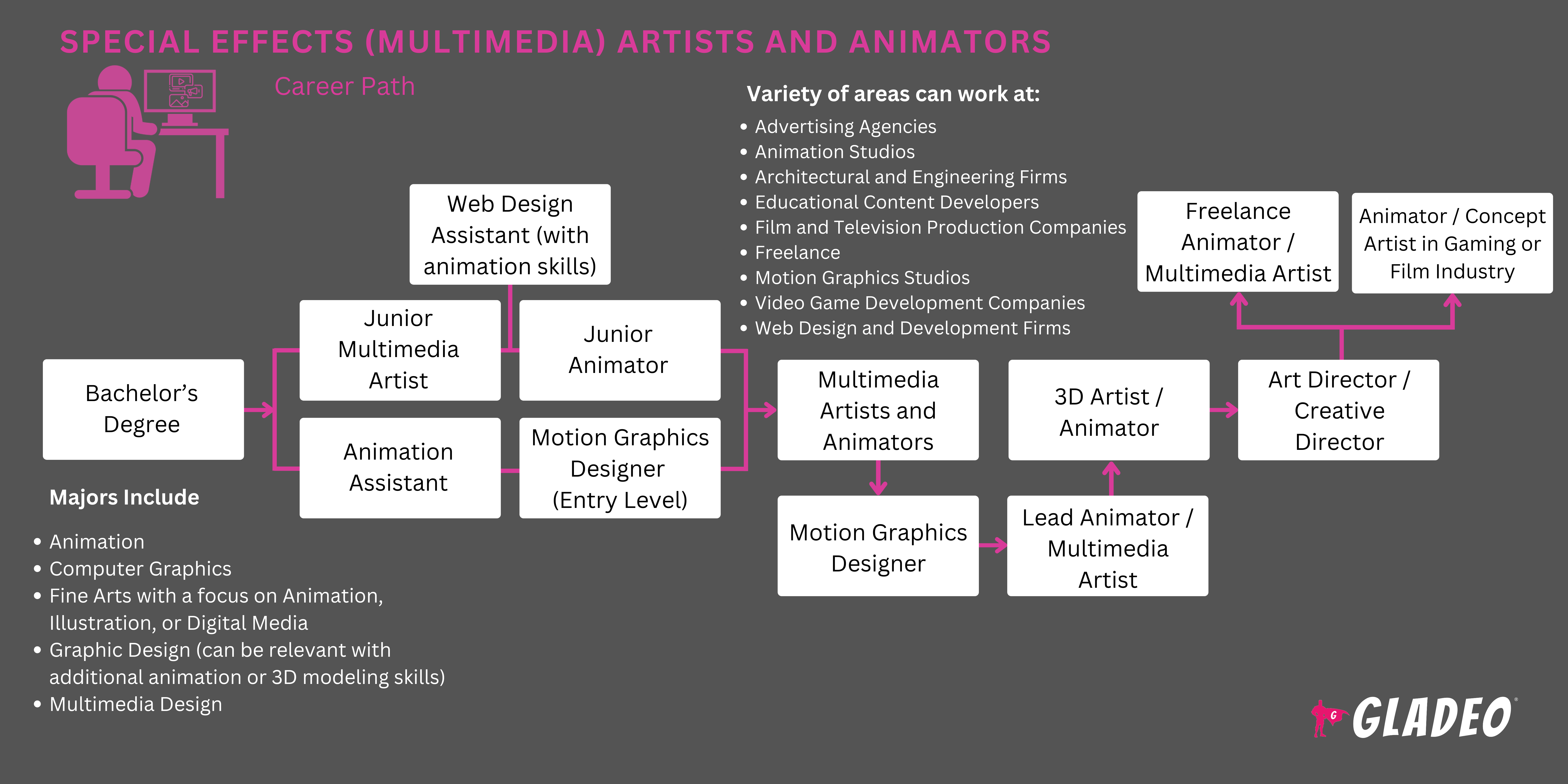스포트라이트
3D 애니메이터, 디지털 아티스트, 일러스트레이터, 멀티미디어 제작자, 애니메이터, 컴퓨터 디자인 부품이라고도 합니다.
우리 모두는 컴퓨터 생성 이미지(CGI)를 사용한 놀라운 시각 효과(VFX)가 돋보이는 애니메이션 쇼나 영화를 본 적이 있을 것입니다. 이 놀라운 작업은 특수 효과 아티스트와 애니메이터라고도 하는 재능 있는 멀티미디어 아티스트들이 해냅니다!
특수효과 아티스트와 애니메이터는 감독, 프로듀서 및 기타 크리에이티브 전문가와 긴밀히 협력하여 스토리텔링을 강화하는 시각 효과를 개발하고 구현합니다. 이들의 작업은 영화, 텔레비전 프로그램, 광고, 비디오 게임 스튜디오에서 상상력이 풍부한 캐릭터와 세계에 생명을 불어넣습니다.
이 직업은 사실적이거나 환상적인 요소를 디자인, 렌더링, 합성하여 라이브 액션 영상에 매끄럽게 통합하기 위해 예술적 기술과 기술적 기술의 특별한 조합이 필요합니다. 이 역동적인 분야는 정교한 AI 도구의 사용 증가로 인해 빠르게 변화하고 있으며, 아티스트는 유연성을 유지하고 지속적인 학습에 전념해야 합니다.
- 게임, 쇼, 영화에서 상상력을 자극하는 콘셉트 구현하기
- 최첨단 기술과 함께 일할 수 있는 기회
- 유명 프로젝트에서 크리에이티브 팀과 협업하기
- 전 세계 시청자가 즐기는 내 작품 보기
근무 일정
특수효과 아티스트와 애니메이터는 일반적으로 풀타임으로 근무하며 마감일을 맞추기 위해 초과 근무를 하는 경우가 많습니다. 작업 환경은 스튜디오와 프로덕션 하우스부터 원격 세트장까지 다양합니다.
작업은 생산 유형에 따라 다릅니다. 예를 들어, 짧은 작업은 며칠밖에 걸리지 않을 수 있습니다. 완전 애니메이션 쇼와 영화 프로젝트는 몇 달 또는 몇 년이 걸릴 수 있습니다. 광범위한 시각 효과(VFX)가 사용된 실사 영화도 사전 제작 컨셉 아트와 포스트 프로덕션 작업을 완료하는 데 몇 달이 걸릴 수 있습니다.
경험이 많은 아티스트는 사전 시각화 및 촬영 현장 감독 역할을 맡을 수 있습니다. 이들은 감독 및 촬영 감독과 협업하여 그린 스크린 설정, 모션 캡처, 트래킹 마커, 특정 카메라 움직임에 대한 지침을 제공하여 나중에 포스트 프로덕션 효과를 추가할 수 있도록 합니다.
일반적인 의무
- 프로젝트 팀과 만나 요구 사항과 일정에 대해 논의하세요.
- 프로젝트의 필요에 따라 디자인이나 애니메이션을 연구하고 구현합니다.
- 시각 효과를 스케치하거나 스토리보드를 작성하여 제작 전에 특정 효과의 모양을 명확히 할 수 있습니다.
- 컴퓨터 소프트웨어를 사용하여 캐릭터, 오브젝트, 환경을 디자인, 모델링, 텍스처링, 애니메이션으로 표현할 수 있습니다.
- 빛, 색상, 질감, 그림자, 투명도를 조작하여 오브젝트와 캐릭터를 더욱 생동감 있게 표현할 수 있습니다.
- 폭발, 불, 물, 기타 동적 요소와 같은 물리적 효과를 시뮬레이션합니다.
- 감독, 애니메이터 또는 클라이언트의 피드백을 기반으로 애니메이션과 효과를 편집합니다.
- 시각 효과를 실사 영상과 통합하여 매끄러운 블렌딩과 사실감을 보장합니다.
- 모든 효과 요소에서 일관성과 품질 관리를 보장합니다.
- 렌더링, 합성 및 애니메이션 워크플로와 관련된 기술적 문제를 해결하고 문제를 해결합니다.
College Gazette는 "VFX의 대부분은 CGI, 합성, 모션 캡처(MOCAP)의 세 가지 범주로 나눌 수 있습니다..."라고 설명합니다. CGI는 거의 모든 것의 3D 모델을 만드는 데 사용할 수 있습니다. 합성에는 그린 스크린이 필요하며 멀리 떨어져 있는 두 요소를 같은 위치에 있는 것처럼 보이도록 조작하는 작업이 포함됩니다. 모션 캡처는 말 그대로 배우의 움직임과 얼굴의 뉘앙스를 녹화하고 이를 CGI 배우나 오브젝트에 적용하는것입니다."
추가 업무
- 수묵 일러스트나 스케치를 만들어 스캔하고 디지털 애니메이션으로 변환하세요.
- 광학 스캐닝과 같은 모델링 기법을 사용하여 실제 개체를 애니메이션 형태로 변환합니다.
- 프로덕션용 디지털 에셋을 조립하고 조판합니다.
- 애니메이션 오브젝트의 동작을 시뮬레이션하여 사실적인 모션을 만듭니다.
- 모션 캡처 퍼포먼스에 시각 효과를 추가하세요.
- 디에이징 또는 CGI 향상 기능을 사용하여 배우의 기능을 조정합니다.
- 스턴트 코디네이터, 특수 효과 팀 및 기타 부서와 협업하여 시각 효과를 실제 장면에 맞게 조정합니다.
- 마케팅을 위한 프로모션 제품 및 프레젠테이션을 개발합니다.
- 개정 사항을 추적하세요. 사용 방법 안내 및 연속성 문서를 작성하세요.
- 최신 업계 소프트웨어, 도구 및 기술을 최신 상태로 유지하세요.
소프트 스킬
- 능동적 인 듣기
- 적응성
- 세부 사항에주의
- 합작
- 통신
- 개념화 기술
- 창조성
- 의사 결정
- 디테일 지향
- 융통성
- 조직 기술
- 독창성
- 끈기
- 고집
- 계획
- 문제 해결
- 팀워크
- 시간 관리
- 시각적 스토리텔링
기술 능력
- 360도 동영상 제작 도구
- 3D 모델링 및 텍스처링
- 애니메이션 소프트웨어(예: 마야, 블렌더)
- 인공 지능 도구
- 색 이론과 조명
- 컴퓨터 코딩 및 VFX 파이프라인
- 데이터 시각화 도구(Tableau, Power BI)
- 디지털 자산 관리 시스템
- 어도비 애프터 이펙트, 마야, 누크 등과 같은 VFX 프로그램.
- 디지털 특수 효과 및 포스트 프로덕션 프로세스
- 게임 엔진 (Unity, Unreal)
- 그래픽 디자인 및 동영상 편집 프로그램(Adobe Creative Cloud, Final Cut Pro, Canva)
- 멀티미디어 형식, 압축 및 파일 관리
- Lightroom과 같은 사진 편집 도구
- 사실적인 애니메이션을 위한 물리학과 해부학
- Python, C++ 등의 프로그래밍 언어
- 프로젝트 관리 기술
- 프레이밍 및 스테이징 샷
- 동영상 편집, 애니메이션 또는 그래픽 디자인 전문성
- 가상 현실(VR) 및 증강 현실(AR) 콘텐츠
- 광고 대행사
- 애니메이션 스튜디오
- 영화 및 텔레비전 제작사
- 프리랜서 기회
- 비디오 게임 개발자
- VFX 스튜디오
이 직업은 예술적 재능과 기술적 숙련도, 그리고 압박감 속에서 일할 수 있는 능력이 조화를 이루어야 합니다. 특히 마감 기한이 촉박하거나 변경 또는 새로운 장면에 대한 요청이 많은 경우, VFX 회사에서 일한다는 것은 긴 시간을 의미할 수 있습니다.
특수효과 아티스트와 애니메이터는 종종 짧은 작업 기간에도 불구하고 관객의 높은 기대치를 충족하거나 그 이상의 고품질 시각적 콘텐츠를 제작해야 합니다. 서두르거나 '나쁜' VFX는 비용이 많이 드는 영화의 평판을 떨어뜨려 흥행에 실패하고 스튜디오의 재정에 손해를 끼칠 수 있습니다.
스트리밍 플랫폼은 엔터테인먼트 환경에 혁신을 가져왔고, 시청자는 거의 모든 프로그램이나 영화에서 고품질의 비주얼을 요구합니다. 다행히도 특수 효과와 애니메이션의 세계는 첨단 소프트웨어가 VFX와 애니메이션 제작 방식을 변화시키면서 도전에 직면해 있습니다. 아티스트는 영화, 쇼, 게임 및 기타 프로젝트에서 그 어느 때보다 디테일한 환경, 캐릭터, 동적 효과를 제작할 수 있습니다.
전통적인 실제 효과는 여전히 영화에서 그 자리를 지키고 있지만, 대부분의 영화 제작자는 디에이징 기술 및 CGI와 같은 디지털 도구를 채택하고 있습니다. 이러한 도구는 복잡한 프로세스를 간소화하여 소규모 팀도 전문가 수준의 효과를 사용할 수 있게 해줍니다. 이러한 툴을 통해 크리에이터는 디지털과 실사 요소를 매끄럽게 혼합하여 시청자가 VFX를 보고 있다는 사실을 모를 정도로 자연스러운 비주얼을 구현할 수 있습니다.
한편, 증강 현실과 가상 현실과 같은 기술은 게임 아티스트가 복잡한 시뮬레이션, 사실적인 캐릭터 디자인, 놀라운 실시간 오버레이를 제작하는 데 도움이 되고 있습니다!
특수효과 아티스트와 애니메이터는 종종 그림 그리기, 스토리텔링, 비디오 게임을 즐겼습니다. 이들은 영화 시각 효과에 매료되어 애니메이션을 미세 조정하거나 최신 소프트웨어에 대해 배우며 시간을 보냈을 가능성이 높습니다.
- 특수 효과 아티스트와 애니메이터는 일반적으로 디지털 아트 중심 학교의 자격증이나 시각 효과, 모션 그래픽 또는 컴퓨터 애니메이션 학사 학위가 필요합니다.
- 일반적인 VFX 과정에는 다음이 포함될 수 있습니다:
- 3D 모델링 및 애니메이션
- AI 기반 합성
- 애니메이션 및 모션 그래픽의 AI
- AI 기반 VFX 기술
- 아티스트를 위한 해부학
- 크로마 키 기법(녹색/파란색 화면)
- 클로스 시뮬레이션 및 이펙트
- 시각 효과를 위한 합성
- 낮에서 밤으로 전환하는 기술
- 영화 및 미디어용 디지털 메이크업
- 경기 이동 및 카메라 추적
- Maya와 NUKE 워크플로 통합
- 파티클 시뮬레이션 및 이펙트
- 시각 효과를 위한 프로젝션 매핑
- VFX의 불꽃과 폭발
- 설정 확장 및 환경 생성
- 스테레오스코픽(3D) 효과 및 뎁스 생성
- 타임 워핑 및 슬로우 모션 효과
- 많은 학생들이 임시 온라인 강좌, 자율 학습, 실습 또는 독립적인 동영상 프로젝트(
)를 통해 기술을 향상시킵니다. 커뮤니케이션, 리더십, 팀 빌딩, 갈등 해결, 프로젝트 관리 등의 강좌가 도움이 될 수 있습니다. - 관련 소프트웨어에 대한 실질적인 실습 경험은 필수입니다. 온라인 강좌는 새로운 기술을 익히는 데 유용합니다! 다음과 같이 이력서를 돋보이게 할 수 있는 다양한 선택적 인증이 있습니다:
- Adobe Systems Incorporated - Adobe 공인 애프터 이펙트 전문가
- Apple Computer, Inc - Apple 공인 프로: Logic Pro X
- Autodesk, Inc. - Maya 공인 전문가
- 공인 디지털 아티스트 - 시각 효과(애니메이터) 자격증
- CG 스펙트럼 - 시각 효과 디플로마
- 파운드리 - Nuke 인증 전문가
- 노몬 - 디지털 프로덕션 자격증
- Rebelway - VFX 아티스트 인증
- SideFX 교육
- 강력한 포트폴리오 또는 이펙트 릴은 역량을 입증하는 데 도움이 될 수 있습니다.
특수효과 아티스트와 애니메이터에게 항상 대학 학위가 필요한 것은 아니지만, 학위 취득을 계획하고 있는 분이라면 학위가 필요한 프로그램을 찾아보세요:
- 공인 인증 기관의 인증.
- 실제 업계 경험을 갖춘 강사.
- 특히 AI와 관련된 최첨단 장비 및 소프트웨어.
- 애니메이션 및 효과 스튜디오에서 인턴십을 통해 실무 경험을 쌓을 수 있는 기회를 제공합니다.
- 업계 전문가와 네트워크를 형성할 수 있는 기회.
- 유연한 수업 일정.
- 취업 알선 및 이력서 작성에 도움을 주는 커리어 서비스입니다.
- 경쟁력 있는 수업료와 수수료, 장학금 및 재정 지원 옵션을 제공합니다.
많은 커뮤니티 칼리지, 교양 대학, 대학교에서 애니메이션, 그래픽 디자인, 시각 효과 또는 멀티미디어 아트에 중점을 둔 미술 분야에서 관련 학위 및 인증서를 제공합니다.
Coursera와 같은 온라인 플랫폼은 유용한 임시 강좌와 자격증을 제공합니다. 학생들은 다음 회사에서 제공하는 강좌를 수강할 수도 있습니다:
- Adobe Systems Incorporated - Adobe 공인 애프터 이펙트 전문가
- Apple Computer, Inc - Apple 공인 프로: Logic Pro X
- Autodesk, Inc. - Maya 공인 전문가
- 공인 디지털 아티스트 - 시각 효과(애니메이터) 자격증
- CG 스펙트럼 - 시각 효과 디플로마
- 파운드리 - Nuke 인증 전문가
- 노몬 - 디지털 프로덕션 자격증
- Rebelway - VFX 아티스트 인증
- SideFX 교육
또한 대학 가제트의 미국 최고의 시각효과(VFX) 대학에서 노몬 및 기타 고려할 만한 프로그램에 대한 전체 리뷰를 확인하세요!
- 미술, 일러스트레이션, 그래픽 디자인, 컴퓨터 코딩 및 프로그래밍, 커뮤니케이션 분야의 강좌를 준비하세요.
- 소프트 스킬을 개발하는 데 소홀히 하지 마세요! 팀워크, 프로젝트 관리, 조직, 시간 관리, 갈등 해결에 대해 배울 수 있는 활동에 참여하세요.
- 영화에서 시각 효과가 어떻게 작동하는지 살펴보세요 : 마스터클래스의 4가지 VFX 유형에 대한 가이드.
- 독학으로 학습하고 집에서 연습하세요. 프로젝트에 VFX를 추가해야 하는 친구나 커뮤니티 회원을 찾아보세요.
- 돈을 받으면서 더 많은 경험을 쌓고 싶다면 Upwork, Freelancer 또는 기타 사이트에서 프리랜서로 활동하는 것을 고려해 보세요!
- 학습 서적, 기사, 동영상 튜토리얼(리소스 > 웹사이트 목록 참조). VFX 매거진과 VFX 보이스는 인기 있는 간행물입니다.
- 다양한 TV 프로그램과 비하인드 스토리를 시청하세요. 눈에 보이는 VFX를 메모한 다음 어떻게 제작되었는지 조사해 보세요.
- 최고의 VFX 회사에 대해 알아보세요. 그들의 역사를 읽고 아이디어와 영감을 얻으세요.
- 현직 특수효과 아티스트에게 정보 제공 인터뷰를 할 시간이 있는지 물어보세요.
- 가능한 한 많은 VFX 기술과 프로그램에 익숙해지세요.
- 온라인 포트폴리오를 개설하여 실력을 뽐내 보세요. 소셜 미디어를 통해 작업을 공유하고 평판을 쌓으세요.
- 영화 인턴십에 지원하고, 영화제 및 영화학교 오픈 이벤트에 참석하고, 전문 단체에 가입하여 네트워크를 배우고 성장하세요.

- 충분한 학력과 탄탄한 포트폴리오를 갖추고 있다면 Indeed, Simply Hired, Glassdoor와 같은 영화 구직 사이트 및 포털에서 VFX 아티스트 일자리에 지원하세요.
- 일하고 싶은 VFX 회사의 채용 페이지를 살펴보세요. 인턴십이나 초급 직무를 통해 입문 단계를 밟아보세요.
- 교수, 상사, 동료에게 개인 추천서 역할을 해줄 수 있는지 물어보세요.
- Upwork, Fiverr 및 관련 사이트에서 프리랜서로 활동하며 경험을 쌓으세요.
- 영화제에 출품하고 업계 저널이나 인기 웹사이트에 게시하세요.
- 캘리포니아, 뉴욕, 텍사스 등 고용 수준이 높은 주나 도시로 이전하여 커리어 기회를 극대화할 준비를 하세요.
- Quora 또는 온라인 VFX 포럼에서 직무에 대한 조언을 구하세요.
- 학교의 커리어 센터에 이력서, 모의 면접, 구직에 대한 도움을 요청하세요. 또한 전문가 네트워크에 연락하여 채용 정보에 대한 조언을 구하세요.
- VFX 아티스트 이력서 템플릿을 검토하여 서식과 문구에 대한 아이디어를 얻으세요. 구인 광고에 나열된 키워드를 검토하여 이력서에 반영해 보세요:
- 3D 애니메이션
- 어도비 크리에이티브 스위트(포토샵, 일러스트레이터, 프리미어 프로)
- 효과 후
- 믹서
- 합성
- 컴퓨터 생성 이미지(CGI)
- 컨셉 아트
- 그린 스크린/크로마 키
- 키프레임 애니메이션
- 조명/음영
- Maya
- 모션 그래픽
- 파티클 시스템
- 포스트 프로덕션
- 실용적인 효과
- 렌더링
- 리깅
- 스토리보드 제작
- 텍스처 매핑
- 시각 효과(VFX)
- "처음부터 특수 효과를 만들어야 했던 프로젝트를 설명해 주시겠어요?" 또는 "특정 효과를 만드는 과정을 설명해 주시겠어요?" 같은 VFX 아티스트 인터뷰 질문을 공부해 보세요.
- 인터뷰에 들어가기 전에 최신 업계 동향을 파악하고 용어를 숙지하세요.
- 면접 요청을 받으면 고용주에 대해 자세히 알아보세요.
- 성공적인 면접을 위해 항상 적절한 복장을 갖추세요!
- 면접 후에는 감사 이메일을 보내 감사의 뜻을 전하고 채용에 대한 관심을 다시 한 번 표현하세요.
- 직속 상사와 경력 발전에 대해 이야기하세요.
- 추가 교육과 훈련을 받고 고급 동영상 편집, 애니메이션, 모션 그래픽과 같은 전문 기술을 연마하세요.
- 최고 품질의 작품으로 포트폴리오와 릴을 업데이트하세요.
- 소셜 미디어, 블로그 또는 전문 플랫폼에 작품을 공유하여 도달 범위를 넓히세요.
- 다른 크리에이터 및 인플루언서와 협업하여 오디언스를 늘리세요.
- AI 기반 도구나 새로운 미디어 형식과 같은 업계 도구, 기술, 트렌드에 대한 최신 정보를 받아보세요.
- 도전적이거나 주목할 만한 프로젝트에 자원하여 자신의 야망과 역량을 보여주세요.
- 회의 중에 혁신적인 아이디어를 제안하고 적극적으로 추가 책임을 모색하세요.
- 후배 팀원을 멘토링하고 상사, 동료 및 업계 리더와 관계를 구축하세요.
- 전문가 단체에서 활발하게 활동하세요. 업계 이벤트에 참석하고 온라인 포럼이나 그룹에 참여하여 최신 정보를 얻으세요.
- 프로젝트를 제시간에 예산 범위 내에서 일관되게 제공하여 신뢰와 인정을 얻으세요.
- 블로그, 소셜 미디어 또는 워크샵을 통해 업계 인사이트를 공유하세요.
웹사이트
- 영화예술과학아카데미
- 액세스 VFX
- ACM 시그라프
- 액션 컷 인쇄
- 동물 논리
- 애니메이션 길드
- 애니메이션 스킬넷
- 애니메이션 월드 네트워크
- VFX의 예술
- 컴퓨팅 기계 협회
- 새로운 학교
- 카툰 네트워크 스튜디오
- 시네필리아와 그 너머
- 코믹 아트 전문가 협회
- 디지털 도메인
- 드림웍스 애니메이션
- 앙코르 VFX
- 영화 제작자 잡지
- 영화 제작자 연합
- 영화 폭동
- 영화 학교 거부
- 프레임스토어
- FX 가이드
- 인디와이어
- 산업용 조명 및 매직
- 루카스필름 애니메이션
- 루마 사진
- 메소드 스튜디오
- 영화사
- 국립 예술 및 디자인 학교 협회
- 국립 만화가 협회
- 예술을위한 국립 기부
- 니켈로디언 애니메이션
- 영화 학교 없음
- 픽사
- 러프 드래프트 스튜디오
- 애니메이션 연구 협회
- 영화 및 텔레비전 엔지니어 협회
- 소니 픽처스 이미지웍스
- 학생 영화 제작자
- 스튜디오 지브리
- OpenFX
- VFX 매거진
- VFX 솔저
- VFX 음성
- VFXWorld 매거진
- 시각 효과 학회
- 월트 디즈니 애니메이션 스튜디오
- 워너 브라더스 애니메이션
- 웨타 디지털
- 위스키트리
- 유선 - 디자인 FX
책
- 영화와 비디오를 위한 디지털 합성: 프로덕션 워크플로우와 기법, Steve Wright 저
- 인사이드 VFX: 시각 효과와 영화 비즈니스에 대한 내부자의 관점, 피에르 그레이지와 스콧 로스의 글
- 애니메이터의 서바이벌 키트, 리처드 윌리엄스 저
- 3D 컴퓨터 애니메이션과 효과의 기술, 아이작 컬로우 저
특수효과 아티스트나 애니메이터는 감독, 프로듀서 또는 슈퍼바이저가 원하는 대로 정확하게 표현하기 위해 오랜 시간과 엄청난 압박감을 감수해야 합니다. 보람이 크고 역동적인 직업이 될 수 있지만, 더 많은 옵션을 탐색하고 싶다면 다음 직업을 고려해 보세요!
- 아트 디렉터
- 북 일러스트레이터
- 코믹북 일러스트레이터
- 컴퓨터 프로그래머
- 카피라이터
- 의상 디자이너
- 크리에이티브 디렉터
- 디지털 마케팅 전문가
- 감독
- 전시 예술가
- 영화 및 비디오 편집자
- 게임 디자이너
- 그래픽 디자이너
- 마케팅 코디네이터
- 사진사
- 팟캐스트 프로듀서
- 홍보 전문가
- SEO 전문가
- 소셜 미디어 관리자
- UX 작성자
- 비디오 게임 디자이너
- 비디오그래퍼
- 비주얼 개발 아티스트
- 웹 콘텐츠 관리자
뉴스 피드

풋힐의 프로그램
주요 채용 정보

온라인 과정 및 도구










